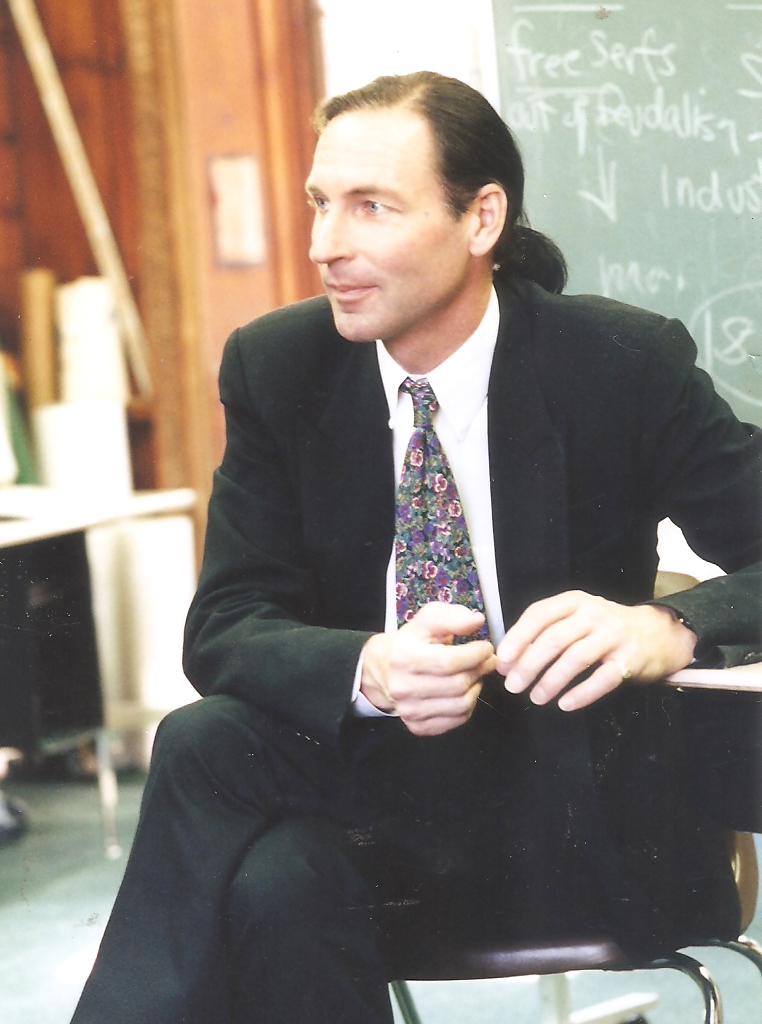To mark Teacher Appreciation Week, EMS salutes the amazing educators, past and present, who make lasting contributions to the lives of their students, their students’ families, and their colleagues. Here we take a look at EMS teaching icon, George Penny. This story originally appeared in the Winter ’21 edition of Apple Tree magazine.
Written by Angelique Morelli

Whether it’s finding the circumference of a tree trunk on Pie Day, to directing Euripides’ play, The Bacchae; Or memorizing the first paragraph of the general prologue of The Pardoner’s Tale, to teaching prepositions; George Penny has taught many lessons over his storied career in education. However, his students at The Elisabeth Morrow School taught him one of the greatest lessons of all.
“We’re not just educating the mind or educating the heart…I’ve seen wisdom in children,” Penny reflects. “Their experience in life is more direct. They come up with stuff that you couldn’t imagine. I swear, in middle school, I’ve met angels who decided to come down to earth to see what life is like. I have met so many great kids.”
Dr. Anil Ranawat ’86 distinctly remembers Penny for his creative approach to teaching and bringing his love of history to life.
“Mr. Penny was probably the single most influential teacher I have ever had,” recalls Dr. Ranawat. “[…]He brought history alive to me, which is a passion of mine to this day. He always took the road-less-traveled approach. He was kind of a hippie and free thinker in a time of more rigidity.”
A Different Path
For those who had the privilege of being a student of Penny’s, it’s hard to believe that he didn’t plan on being a teacher. The Long Island, N.Y, native who was once an aspiring fireman (and cowboy), says that he was painting houses and pictures (and sold a few) before falling into the teaching profession. An anthropology major, Penny had taken some education courses but never was certified and never thought of working in private education. He even had the chance to work in puppetry, but the opportunity never came to fruition. Although years later, he would bring his puppetry skills to EMS for the Summer Strings Festival.
In the late 1970s, Penny and his wife, Leslie, were studying at The School of Practical Philosophy in New York City. With $1,000 in the bank and a packed moving truck, the Pennys were on their way to move to Jackson Heights, Queens, to be closer to the school. But when they learned through an acquaintance that Far Brook, a school in Short Hills, N.J., was looking for teachers, the Pennys’ interest piqued.
Penny and his wife took a chance, applied, and were both hired on the spot: Penny was hired to work as an assistant in the nursery school, and his wife was hired to be a kindergarten teacher.
The Three Cs
While Penny credits Far Brook with his “grounding in education,” when he thinks back to his over three decades at The Elisabeth Morrow School, he is reminded of the supportive mentorship he received from colleagues – namely, Jean Milliren, Jean Gilbert, and Jeanette Kurk – countless memories of his students, and the child-centered approach to teaching for which EMS is known.
“EMS was child-centered before they invented the term,” Penny says. This practice was supported by what was then, The 3 Cs.
“I walked into a world dominated by the 3 Cs. In fact, when the fourth C was put in by Germaine DiPaolo, I still used to dwell on the 3 Cs, but say that the fourth C is a result. The nice thing about the 3 Cs is that they’re practical,” says Penny.
Temple of Learning
“[Every day] in the 15 or 20 minutes that [the students] were coming in [to homeroom], I stood by the door and would shake their hand as they would come into the room,” recalls Penny. “It acknowledges your humanity and acknowledges you as a scholar.”
Ask any of his former students and they would agree that being child-centered was a part of Penny’s classroom culture every day. EMS alumnus and former student of Penny, Jesse Roth ’09, refers to him as “an icon in every regard” and remembers a tradition that left an indelible mark.
“On the very last day of the sixth grade, Mr. Penny had a tradition of gifting an original or classic edition of a novel that he believed best represented each student that was in his advisory group that year,” recalls Roth. “Mr. Penny gave me a copy of The Three Musketeers with an amazingly appropriate note inside. This is the kind of teacher Mr. Penny was. He really knew his students.”
Another memorable Penny tradition: City Game.
Adam Kirsch ’07 remembers City Game not just for its creative approach to teaching content but for showing students how to work together.
“My fondest memories of sixth grade involve the City Game, a multi-week activity in which the class was divided into ‘cities’ and tasked with establishing the community’s government, belief system, etc.,” says Kirsch. “I still think about how it blended lessons around creativity, history, and, most importantly, teamwork into a comprehensive and fun experience.”
According to Penny, City Game was inspired by the 1980s game, Dungeons and Dragons. He placed a big board in the middle of the room and would break his students into groups. He says, “it was teaching history through play.”
The memories created and lessons learned in Penny’s classroom aren’t just kept in the hearts of his students.
“I remember in 1993 walking past George’s sixth-grade classroom. It was the end of the day, and all of the students were quietly sitting at their desks while he was reading Chaucer to them in old English. He had a spell on the children, and they were entranced even though it was clear they didn’t really understand what he was saying,” recalls Arts Department Chair Amelia Gold. “At that moment, I realized this was a master teacher weaving in art, history, and beauty into his lessons. George is a true Renaissance man and modeled that ingenuity and creativity with his students. My oldest son, Joshua, was lucky enough to have him in the sixth grade. He inspired Joshua‘s deep love of history and social justice. George Penny is one of those life-changing teachers that leave a mark on every student he taught.”
“I never took that room for granted,” says Penny. “The day would be over, and I would just sit in that room. And when I go to visit EMS [today], I go in there, and I kiss the wall. That room is a temple of learning.”
Today, Penny is known as Professor Penny, as he is an adjunct professor at Seton Hall, Union County College, and Bergen Community College. While he enjoys teaching at the college level, the impact that EMS had on Penny and his career remains.
“EMS gave me more than I gave it. Immeasurably. And EMS students gave me more,” says Penny. “That’s the thing about love. You make that little investment, and it pays off in triplicate.”
High Praise: A letter from a former student of George Penny
I am an alum of Elisabeth Morrow School, having graduated in 1996. Mr. Penny has always been front of mind as the most impacting teacher from my time at EMS. From City Game to building trebuchets to hanging out in Native American sweat lodges to listening to his favorite punk band, Mr. Penny expanded his students’ imaginations and compelled them to think broadly and openly. His class was the stuff of legend, one in which every sixth-grade student wanted to be. Never someone to shy away from an opportunity to impart a worldly lesson, Mr. Penny constantly pushed his students to think differently, even if that meant making lessons of some for the greater benefit of the class. While there was a certain palpable fear of becoming the object of Mr. Penny’s lessons, many knew that his ultimate goal was to unearth his students’ talents for their own discovery, a unique and precious gift.
Toward the end of sixth grade, Mr. Penny would give old books to his students — dusty, ancient-looking things that seemed to have been pulled straight off the shelves of a cabinet of curiosities. Inside were personal inscriptions from Mr. Penny to each of his students as they departed the safe hamlet of EMS for the wider world. Mine still sits prominently on my bookshelf, a 1939 edition of The Mutiny of the Bounty and Other Sea Stories, with an encouraging note penned in the inside front cover from Mr. Penny that in part reads: “You may not know it, but it’s obvious from what you say and write, that you have something to say. Find a way to say it. Speak up, because every generation needs men of conscience, tolerance, and reason.”
Mr. Penny inspired wonder and nurtured the life of the mind while grounding his students in truth and humanity. Being his student helped to shape my life, and that of my younger brother Daniel, who was also fortunate enough to land in his class. While not quite as reticent as in my youth, I am still finding a way to say things and fulfill his exhortation.
Thank you for all of your years as an educator, Mr. Penny.
Sincerely,
Steven Maroti
EMS Class of 1996


